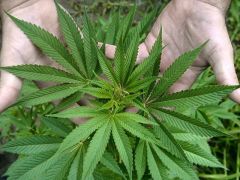“Researchers from Brazil’s prestigious University of Sao Paulo have discovered that marihuana contains substances which can help ease the collateral effects of medicines prescribed to patients suffering from Parkinson disease.”
“Six patients with Parkinson were given during a whole month small doses of “canabiodiol” one of the 400 substances in marihuana, following which encouraging results were confirmed according to scientists from the Riberao Preto Medicine School from the SP University.
“Patients with Parkinson developed improvements in their sleeping alterations, in their psychotic symptoms and could even reduce their trembling” said psychiatrist Jose Alexander Crippa, Neuro-sciences Department professor.
The paper on the discovery was published last November and next year an additional paper with test results on the anxiolytic effects of “canabiodiol” in patients with obsession and compulsion disorders will be released.
A group of voluntary patients with obsessive and compulsive conducts were medicated with the substance 70 minutes before facing situations that forced them into anxiety fits, and “improvements were evident”.”


